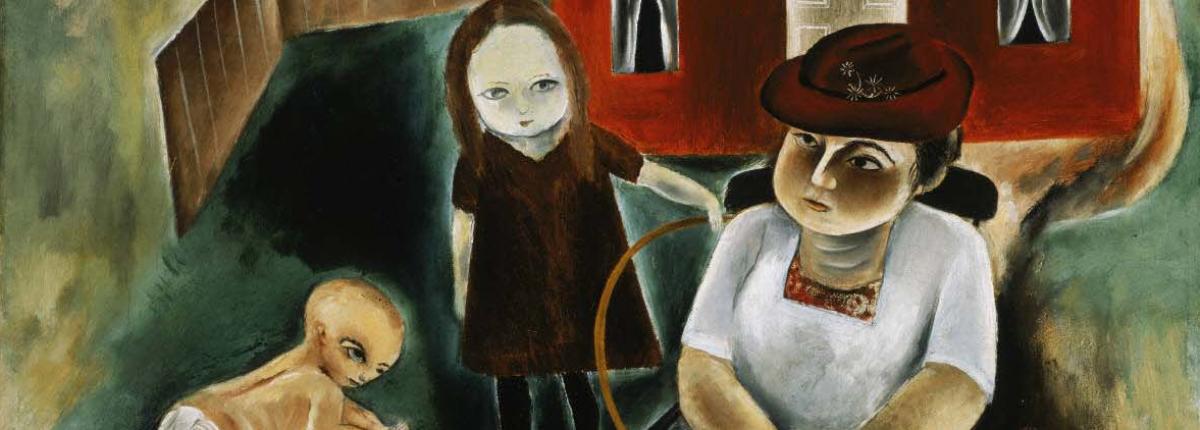Remembering Yasuo Kuniyoshi
This article is based on a conversation among Stephen Diamond, Rebecca Shipman, Camille Brown, and Adrienne L. Childs on June 6, 2023.
From the Seeing U.S. Research Project

We sat down with Stephen Diamond to discuss his memories of his uncle Yasuo Kuniyoshi and his ongoing efforts to preserve and promote the artist’s legacy. Kuniyoshi’s painting Maine Family will be featured in the exhibition Seeing U.S.
Family
Stephan Diamond’s aunt Sarah Mazo married Yasuo Kuniyoshi in 1935. Diamond recalled that his aunt was an actress and dancer who also worked as an artist’s model. She modeled for Kuniyoshi and eventually became his second wife. Diamond said that the family was supportive of their union, even though it was unusual for a white woman to marry an Asian man in the 1930s. Diamond spoke of visiting his aunt and “Uncle Yas” in their small Greenwich Village apartment. Kuniyoshi spent a great deal of time in his studio on 14th Street, and Diamond had fond memories of bringing his grade school class on a tour there.

Max Yavno, Yasuo Kuniyoshi in his studio, 1940 Oct. 31. Federal Art Project, Photographic Division collection, c. 1920-65. Archives of American Art, Smithsonian Institution.
Diamond’s family also visited Mazo and Kuniyoshi at their home in Woodstock, New York, where the artist kept another studio. As was his practice in New York City, Kuniyoshi spent many hours at work there. He was also an avid photographer and took many photos of family gatherings. He also made use of photography in his artistic practice.
An American Artist
Kuniyoshi was born in Japan but spent most of his life in the United States. He studied at the Art Students League in New York City, where he became a well-respected member of the vibrant modern art scene. Diamond stated that it was important to Kuniyoshi that he be considered an American artist, and his uncle worked hard to maintain that distinction. After the Japanese attack on Pearl Harbor and the entry of the United States into World War II, Kuniyoshi was labeled an “alien enemy,” but he was nonetheless supported by his family and many friends in the art world. Diamond—a photographer himself—felt particularly bad about the fact that the authorities took Kuniyoshi’s camera and binoculars away from him, which interfered with his artistic process. Nevertheless, Kuniyoshi supported the U.S. war effort. “He went out of his way to help the Americans defeat Japan in the war,” said Diamond.
Diamond recalled that his aunt Sarah worked hard to help Kuniyoshi become a citizen. She corresponded with politicians to petition on his behalf. Although the artist was never granted citizenship, Diamond revealed that his aunt told her husband on his deathbed that he had become a citizen, comforting him at the end of his life.
Legacy
After Sarah Mazo’s death, the Kuniyoshi estate was bequeathed to Diamond, the only remaining family member connected to the artist. Diamond felt strongly about ensuring that Kuniyoshi’s work was well represented in American museums in accordance with the artist’s ardent desire to be viewed as American artist. Diamond inherited a considerable number of Kuniyoshi lithographs, many of which are based on his major paintings. He has donated lithographs to museums in the United States and around the world that hold Kuniyoshi works in order to support his work. The Phillips Collection has three lithographs by the artist. To further the artist’s legacy, Diamond sponsored a scholarship in Kuniyoshi’s name at the Art Students League and is doing everything in his power to ensure that the artist will not be forgotten. When asked what he feels Kuniyoshi contributed to the art world in the United States, Diamond replied simply, “He contributed to American art by being a great artist!”

Yasuo Kuniyoshi, Maine Family, c. 1922-c. 1923, Oil on canvas, 30 1/4 x 24 1/8 in., The Phillips Collection, Acquired 1940; Art © Estate of Yasuo Kuniyoshi/Licensed by VAGA, New York, NY